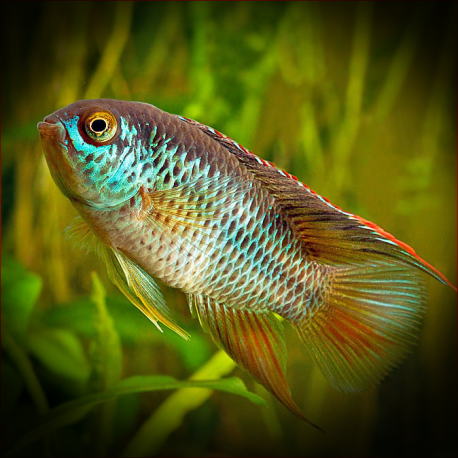More info
Datasheet
| Minimum Tank Size | 40 litres / 10.57 US gallons |
| Maximum Size | 7.6cm / 2.99inches |
| Temperature | 22°C / 71.60°F - 25°C / 77.00°F |
| Hardness | 3-8ºdH |
| pH | 6-7.5 |
General Description
Nannacara Anomala, commonly known as the Golden Dwarf Cichlid, is a peaceful dwarf Cichlid species that is often recommended for beginners in the hobby. They are hardy, attractive, and known for their interesting breeding behaviors. The male of the species is significantly larger than the female and displays vibrant colors like pale blues and reds, while the female is smaller and typically yellow with a distinctive black lateral line on its flank.
Aquarium Setup
For keeping Nannacara Anomala, a well-planted aquarium setup is ideal, with the inclusion of bogwood, driftwood, or mopani wood for cover and spawning sites. The water conditions should be maintained with a pH level between 6 to 7.5, water hardness ranging from 3-8°dH, and a temperature of 22-25°C. A minimum tank size of 40 litres is recommended, and it should be noted that providing appropriate territories for females is essential for breeding.
Behaviour
These Cichlids are known for their peaceful nature and can coexist with other peaceful fish in a community tank. However, female Nannacara Anomala can exhibit high levels of aggression when protecting their fry, posing potential challenges in a community tank during breeding periods. In smaller tanks with multiple males, the subdominant male may mimic female coloration and size to avoid aggression from the dominant male.
Feeding and Diet
In the wild, Nannacara Anomala are micropredators that feed on worms, insects, and other invertebrates. In captivity, they should be offered a varied diet that includes meaty Cichlid pellets as a staple, supplemented with vegetative matter like vegetable or spirulina flakes, as well as live or frozen foods such as bloodworms and brine shrimp.
Reproduction & Dimorphism
Breeding Nannacara Anomala is relatively simple, requiring adequate water conditions and the presence of a male and female pair. Breeding becomes even easier in larger tanks with multiple females providing companionship to a male. Females exhibit a checkerboard-esque pattern when in the breeding mood.
Habitat and Distribution
These Cichlids are commonly found in areas of flooded grassland in low-lying coastal regions. Their natural distribution ranges from the Rio Aruka in Guyana to the lower Rio Marowijne in Suriname. While some specimens are wild-caught, many of those available in the trade are bred on commercial farms in the Far East or Eastern Europe.

